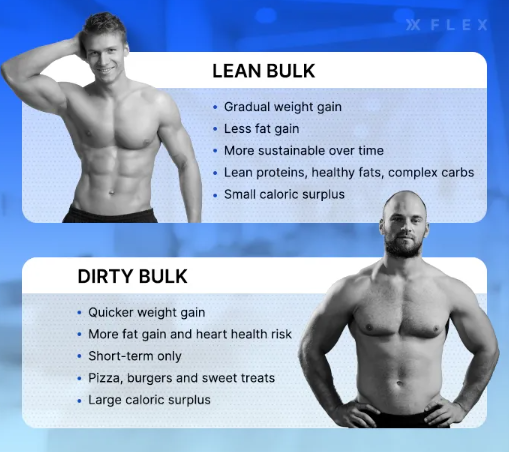PUBLIC HEALTH – Dirty bulk is a term that often stirs up debate in the fitness community. Some see it as a shortcut to gaining muscle mass, while others caution against its potential downsides. If you’re looking to bulk up quickly, understanding the concept of dirty bulk is crucial. This guide will delve into the ins and outs of dirty bulking, helping you make informed choices about your fitness journey.
What is Dirty Bulk?
Understanding the Concept
Dirty bulk refers to a strategy where individuals consume a surplus of calories without worrying too much about the quality of those calories. The idea is simple: eat more to gain weight, typically focusing on high-calorie, less nutritious foods. This approach stands in contrast to a clean bulk, where the emphasis is on nutrient-dense foods.
Why Do People Choose Dirty Bulk?
Many people opt for dirty bulking for several reasons:
- Rapid Weight Gain: If your goal is to gain weight quickly, this method allows you to eat more calories without restriction.
- Simplicity: Dirty bulking often involves fewer meal prep restrictions, making it easier for some to stick to their eating plan.
- Increased Strength: The extra calories can fuel workouts, leading to potential gains in strength and muscle size.
The Pros and Cons of Dirty Bulk
Benefits of Dirty Bulking
1. Faster Muscle Gain
One of the primary advantages of dirty bulking is the speed at which you can gain muscle. With a significant caloric surplus, your body has ample energy to build and repair muscle tissue.
2. Flexibility in Food Choices
Unlike clean bulking, dirty bulking allows for more freedom in your diet. You can indulge in foods you enjoy, making the process less monotonous. Whether it’s pizza, burgers, or ice cream, as long as you’re hitting your calorie goals, you’re good to go.
3. Increased Strength in Workouts
More calories typically translate to more energy. This boost can help you push through workouts, lift heavier, and potentially build strength faster.
Drawbacks of Dirty Bulking
1. Excessive Fat Gain
While you might gain muscle quickly, dirty bulking often leads to significant fat accumulation. This unwanted fat can make it harder to achieve a lean physique later on.
2. Poor Nutritional Choices
Dirty bulking tends to focus on convenience over nutrition. Regularly consuming unhealthy foods can lead to deficiencies in essential vitamins and minerals, which might affect overall health.
3. Long-Term Health Risks
Over time, a diet high in processed and low-quality foods can increase the risk of various health issues, including heart disease and diabetes.
How to Approach Dirty Bulking
Finding the Right Balance
If you choose to embark on a dirty bulk, it’s essential to strike a balance. Here are some tips to help you navigate this approach effectively:
1. Set Clear Goals
Determine what you want to achieve. Are you looking to gain muscle, or is your goal to improve strength? Understanding your objectives will help guide your eating choices.
2. Monitor Your Progress
Keep track of your weight and body composition. Regularly assess how much muscle and fat you’re gaining. This information will help you adjust your calorie intake as needed.
3. Include Some Nutrient-Dense Foods
While the idea of dirty bulking is to enjoy calorie-dense foods, incorporating some nutrient-rich options can help mitigate the negative effects. Consider adding whole grains, fruits, and vegetables into your diet alongside your favorite treats.
Sample Meal Plan for Dirty Bulk
To give you an idea of what a dirty bulk meal plan might look like, here’s a sample:
Breakfast
- Four scrambled eggs with cheese
- Two slices of toast with butter
- A large smoothie made with whole milk, bananas, and peanut butter
Snack
- Protein bar or a donut
Lunch
- Cheeseburger with fries
- Milkshake
Snack
- Trail mix (with nuts and chocolate)
Dinner
- Pasta with creamy sauce
- Grilled chicken or meatballs
- Garlic bread
Evening Snack
- Ice cream sundae or a large bowl of cereal
Transitioning from Dirty Bulk to Cutting
Why You Might Need to Cut
Once you’ve achieved your weight gain goals, you might find yourself wanting to shed some of the excess fat. Transitioning from a dirty bulk to a cutting phase requires careful planning.
Steps to Transition Smoothly
- Gradually Reduce Calories: Instead of cutting your calories drastically, slowly lower your intake to avoid shock to your system.
- Focus on Nutrient-Dense Foods: Shift your focus to high-quality foods that provide essential nutrients without excess calories.
- Increase Physical Activity: Incorporate more cardio into your routine to help burn off excess fat.
Conclusion
Dirty bulk can be an effective way to gain weight and muscle quickly, but it comes with its share of risks. Understanding the benefits and drawbacks will help you make informed decisions about your fitness journey. If you choose to go this route, aim for a balance between indulgence and nutrition. Ultimately, prioritize your health while working towards your goals. Enjoy the process, and remember that consistency is key to any successful fitness strategy
REFERENCE : https://boursessenegal.com/



